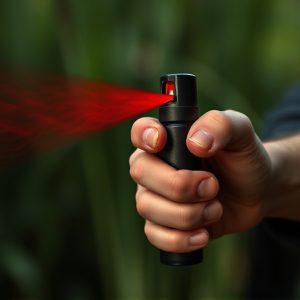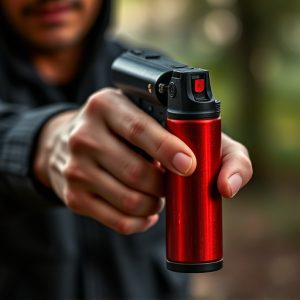Bear Spray Defense: Storage, Application, and Debunking Myths
Maintaining the best storage temperature for pepper spray (bear spray) between 50°F to 70°F…….
Maintaining the best storage temperature for pepper spray (bear spray) between 50°F to 70°F (10°C to 21°C) is crucial to preserve its effectiveness. Extreme heat or cold can degrade the chemical composition, diminishing its potency and range. Proper storage ensures bear spray is ready for use against aggressive bears, offering a vital defense mechanism. Debunking myths about usage and storage conditions, especially regarding temperature, is critical for optimal use in real-world situations.
Bear spray is a powerful tool for defending against unpredictable animal attacks in their natural habitats. This article delves into the effectiveness of bear spray, breaking down its composition, and how it works against bears. We explore optimal storage conditions, crucial for maintaining maximum potency, and application techniques to deter aggressive encounters.
Additionally, we debunk common misconceptions surrounding its use and highlight regulatory aspects and safety precautions. Discover the best storage temperature for pepper spray to ensure its reliability when facing a bear attack.
- Understanding Bear Spray: Composition and Effectiveness
- Optimal Storage Conditions for Maximum Potency
- Application Techniques to Deter Attacking Bears
- Common Misconceptions and Their Debunking
- Regulatory Considerations and Safety Precautions
Understanding Bear Spray: Composition and Effectiveness
Bear spray, also known as pepper spray specifically designed for wildlife defense, is a powerful tool for protecting oneself against aggressive bears. Unlike conventional pepper spray used by law enforcement, bear spray is formulated to be effective at longer ranges and has a faster activation time, making it ideal for outdoor enthusiasts and those living in bear country. It typically consists of capsaicin, the active ingredient found in chili peppers, along with other agents that enhance its potency and stability.
Understanding the best storage temperature for pepper spray is crucial for maintaining its effectiveness. Bear spray should be stored in a cool, dry place, ideally between 50°F to 70°F (10°C to 21°C). Exposing it to extreme heat or freezing temperatures can degrade its chemical composition, reducing its potency and range. Proper storage ensures that when you need it most, the bear spray will be ready for use, providing a crucial layer of protection against these formidable animals.
Optimal Storage Conditions for Maximum Potency
To maintain maximum potency, bear spray should be stored under specific conditions. The best storage temperature for pepper spray is between 50°F and 70°F (10°C to 21°C). Extreme temperatures can degrade the active ingredients, reducing the effectiveness of the spray. It’s important to keep it out of direct sunlight, as UV rays can also accelerate breakdown. A cool, dry place, such as a locked cabinet or safe, is ideal.
Additionally, bear spray should be stored away from heat sources like radiators or ovens. Humidity control is crucial; avoid storing it in damp areas or near bodies of water, as moisture can compromise the integrity of the canister. Regularly check the expiration date and ensure the nozzle remains sealed to prevent any contamination or loss of potency.
Application Techniques to Deter Attacking Bears
When using bear spray as a defense mechanism, proper application techniques are crucial to deterring an attacking bear effectively. The key lies in aiming for the bear’s face and eyes, as pepper spray is most effective when it directly irritates these sensitive areas. Hold the can upright, about 20-30 cm away from the bear, and spray in a sweeping motion across its face. It’s important to remember that one burst might not be enough; repeat the process if needed, especially for larger bears.
Storing your bear spray optimally is also vital for maintaining its potency. The best storage temperature for pepper spray is typically between -20°C and 4°C (4°F to 40°F). Keeping it in a frozen state ensures that the active ingredients remain effective. Avoid extreme heat, as it can cause the spray to lose its strength over time. Proper storage conditions help guarantee that you have a reliable defense mechanism when facing a bear encounter.
Common Misconceptions and Their Debunking
Many people hold misconceptions about bear spray that hinder its effectiveness as a defense mechanism against animal attacks. One common belief is that pepper spray only works on humans, but this isn’t true—it’s designed to incapacitate any large mammal, including bears. Another misconception is that applying bear spray from a distance ensures safety; however, it must be sprayed directly into the bear’s face for maximum impact.
Regarding storage, many users don’t realize the best storage temperature for pepper spray is between 50°F and 70°F (10°C to 21°C). Extreme heat or cold can degrade the spray’s effectiveness. It should be kept in a cool, dry place, away from direct sunlight, and out of reach of children and pets. Debunking these myths is crucial for users to understand how to properly utilize and store their bear spray, enhancing its reliability in real-world scenarios.
Regulatory Considerations and Safety Precautions
When it comes to bear spray defense, understanding regulatory considerations and safety precautions is paramount. Each region has its own guidelines regarding the possession, use, and storage of pepper spray for wildlife deterrence. Always check local laws before purchasing and carrying bear spray, as regulations vary widely.
Proper storage is crucial for maintaining the effectiveness and safety of bear spray. The best storage temperature for pepper spray is typically between 50°F to 70°F (10°C to 21°C). Extreme temperatures can degrade the active ingredients, reducing the spray’s potency. Keep it out of direct sunlight and in a cool, dry place, away from heat sources and freezing conditions, to ensure optimal performance when you need it most.
Bear spray is a valuable tool for deterring aggressive bears, but its effectiveness hinges on proper usage and storage. By understanding the composition, application techniques, and regulatory aspects, users can maximize its potency. Ideal storage conditions, including the best storage temperature for pepper spray, are crucial to ensure its readiness when needed. Dispelling common misconceptions and adhering to safety precautions will further enhance the safety of individuals encountering bears in their natural habitats.


